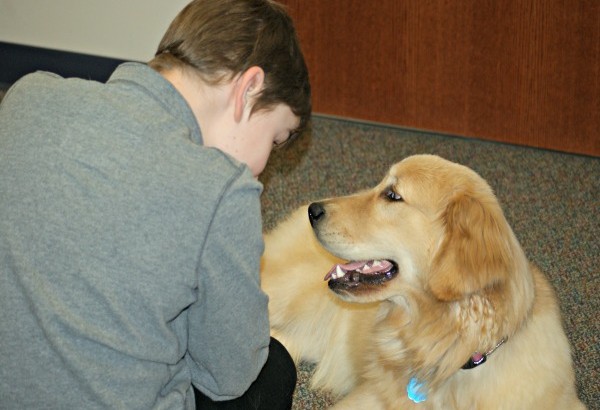Puppy love
Sometimes, it’s good to let things go to the dogs!
I’ve used therapy dogs—all three have been golden retrievers—for nearly 16 years—making important connections with children and others facing a variety of life’s challenges.
Currently, I work on contract as a school-based counselor at the South Williamsport School District with students in kindergarten through sixth grades. The therapy dogs have been an important part of my work.
My first dog was Guinevere (Gwen), and she passed away when she was 15 last spring. She worked with me initially when I was working at the local SPCA as the coordinator of volunteers/humane education presenters. When I returned to Diakon in 2002, she continued to work with me here. Gwen—and later her son, Grizzly—worked with me visiting kids and their families in situations of distress of one sort or another. While I lost Gwen last spring, I lost Grizzly to cancer in 2012.
My current dog, Elli, was born in May 2013 in Erie, Pa. Elli isn’t old enough to be a certified therapy dog yet, but the school district allowed me to bring her to school from the moment she came home with me at eight weeks old. While Elli is my dog and lives with me, she has virtually grown up in school. She loves the kids and the adults! She is viewed as part of our community and we’re all learning about how to raise a pup.
At eight weeks, her teeth were like little sharp razors and we all worked to teach her to chew on toys, rather than on us. She’s nine months old now and although she’s learned some things, there is a great deal left to learn before she’s ready to take her therapy dog certification exam.
However, she’s already completed two obedience classes and we’re working on setting up a therapy dog training preparatory class. She’s a smart little girl and is also all pup! She chewed on a chair or two, chewed through a phone line, and ran after a little girl who ran away from her (Elli thought it was a great game of chase). Another child ran after both of them yelling, “Be a tree” which is a humane education lesson that tells you to stand still when you encounter a loose dog. Elli, obedient pup that she was at that moment, stopped when I called her to come.
She also ate part of a student’s cheese sandwich and put her muddy paws on my white pants just before a meeting. I often say that while Gwen was the dog of my soul and Grizz was the dog of my heart, Elli simply makes me laugh and smile. My school name badge includes her; the photographer was so taken with her she has her own photo. She has a crooked little smile and you can’t help but grin when you see it.
Why do we do this? Because teaching the kids to train a dog helps them understand how they learn.
Dogs are a natural bridge with kids—that’s an easy thing to understand—but they also provide that same calming, engaging, accommodating function with adults as well. My dogs have come to be an accepted—celebrated, really—aspect of my work in the district. Whether we are helping kids who are struggling with intense anxiety or depression, grief, abuse, social pressures, lack of social skills, parental divorce, death, incarceration or other absence, the dogs are there offering that ever-loving, always-accepting presence.
For the kids, it is a special time to get to spend time with Ms. Pat and one of her dogs.
Over the years, we have developed other programs as well.
• Puppy Pals is an evening reading program through the Title I program. Parents come to one of several presentations and the kids come to read to the dogs (I have about ten additional dog handlers who have certified therapy dogs and who support our programs).
• Biscuit Buddies is a once-a-month program in which each kindergarten through fourth grade classroom teacher chooses one child from his or her class to come to the library during lunch. The kids eat (the dogs refrain) and then they read to one of the therapy dogs.
• We also hold evening library nights every other week in the summer. The school opens the library and the dogs come for reading and visiting with kids and families. This is where the kids first met Elli last year, then she greeted them on opening day of school.
• We also periodically provide humane education during which we take the opportunity to teach kids how to be safe around dogs and to learn important lessons in animal care.
• Sometimes we just visit classrooms to help the teacher talk about a particular topic.
• Crisis response is something we do in the school district when there has been a death. We’ve assisted in crises in many other districts as well. Our mission in these instances is to help ease the pain, create a “safe” place, and allow people to talk or be silent with the kind of support that stimulates comfort.
Gwen is the dog that did the out-of-district crisis work with me. She was the most amazing dog! I have many stories of her incredible abilities and sensitivities. We went into districts that in any other circumstance wouldn’t allow a dog and emerged with endless praise and appreciation for all that she brought to the many places of grief.
Gwen, Grizz, and now Elli have all regularly been involved with the special needs class. These kids are now helping to train Elli. We go there most weeks to visit and to work on training. This same class taught both Gwen and Grizz to roll over… this in their later years, so you see, you can teach an old dog new tricks!
Why do we do this? Because teaching the kids to train a dog helps them understand how they learn. The students learn about being positive and clear in communication; they learn about being sensitive to one another; and they learn that each of these dogs is always there for them when they need a hug.
Recently, one boy was having a really tough day so he and his teacher came to find Elli and me. The boy sat on the floor with Elli and talked with her, then started going over all the commands that he’s learned with her; he praised her and she gave kisses in response. After ten minutes, he left with a smile and a “See ya soon, Elli.”
We also recently visited with another boy who had been reporting that he sees dead people—a little scary for the teaching staff. He and Elli are good buds now and he reports that when he feels anxious, having a dog around helps calm him down. He’s back in class now and although the situation has just begun, he is able to feel reassured enough to focus on learning. Sometimes we don’t know what has sparked a traumatic response, but I can tell you that a dog knows when someone needs reassurance; they are able to quietly, calmly provide a safe moment in time—and that makes a big difference.
The dogs are part of teaching us all about life. The school superintendent and principals encouraged me to bring Grizz to school even when he was wearing doggy britches because of his rectal cancer; Gwen came to school until days before she died and Elli, well, they have tolerated tons of puppy behavior here.
The kids were part of caring for the two older ones as they faced death and later we all grieved together. Students made cards and both staff members and students gathered money to donate to the local SPCA in their names. The kids are now watching Elli grow and learn and they are taking part in the training and development of a therapy dog. Although everyone wanted a puppy when she first came, now they know just how much work it is to teach a dog to be mannerly and to live graciously among her people.
And they are learning a good deal about themselves in the process.
Patricia Peltier Russell “Ms. Pat”
Outreach Counselor
Diakon Family Life Services
Because we review comments, they do not appear immediately. Please do not submit each comment more than once. Please review our comment policy.





Love this! Makes me want to try hard(ER) to get Tippy in shape for some therapy work.